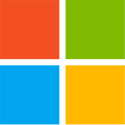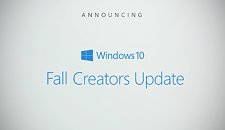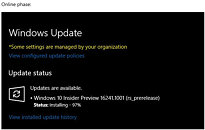Thursday, July 20th 2017

Microsoft Decreasing Windows 10 Updates Downtime in Fall Creators Update
If you're a standard Windows user, you probably find Windows updates something of a pain - especially when they force you to reboot your PC after they're installed. But imagine you own a business that constantly has its machines up and running, but also requires the latest security upgrades; each minute of downtime for installing such updates is lost revenue. Because of that issue, which companies brought to Microsoft's attention over the years, the company is streamlining its update process, decreasing the amount of update steps that need to be taken offline (which means less time waiting for the machines to become available to use following an update.)Usually, in updating your Windows system, there are two phases: an "online" phase, in which your PC automatically checks for new updates and actively downloads required system files while allowing you to keep using the computer for various tasks. The second "offline" phase is where the bulk of the work occurs during the update process, and doesn't allow the user to make use of the machine while this process is taking place (read reboot update sequences, for instance.) With Microsoft's latest streamlining process, two steps that previously took place during the "offline" phase will migrate to the online phase. Namely, 1) user content (apps/settings/configurations) back-up and the laying down of new OS files (Windows Image [WIM] process.)
Microsoft's Jason Howard, in a blog post for the upcoming Windows 10 Fall Creators Update, said that "By moving the old offline portions of the upgrade process to the online phase, upgrades will appear to take longer if you're watching or timing the progress. We didn't want to sacrifice usability for offline time so the upgrade processes are run at a lower priority to provide for best performance."
Sources:
Microsoft Feedback Hub, Via HotHardware
Microsoft's Jason Howard, in a blog post for the upcoming Windows 10 Fall Creators Update, said that "By moving the old offline portions of the upgrade process to the online phase, upgrades will appear to take longer if you're watching or timing the progress. We didn't want to sacrifice usability for offline time so the upgrade processes are run at a lower priority to provide for best performance."



33 Comments on Microsoft Decreasing Windows 10 Updates Downtime in Fall Creators Update
I'm quite curious to see how it affects the performance of the machine
I wouldn't trust a company, that disables Windows Updates.
OFC both of these can be fixed by disabling automatic updates and auto restarts, though the former is still useful for regular office computers (non workstations)
The off-line phases are getting less and less which is great.
It's kind of ridiculous complaining about "tedious" and "time consuming" update process on windows, when your Android and iOS devices nag about updates every day, sometimes several times a day.
My HTC One is fairly clean (less than 10 third-party apps) and runs an older Android 5.0.2, but I still do get updates almost every day, and for some reason (maybe common sense), I do not complain about it.
Sales people who travel still might find it annoying.
but you have this middle ground of test machines, workstations, etc where you really need them always performing their duties. So for compression engineers/graphic designers tend to setup their machines to run all weekend so the job is done when they come back on monday.
windows updates destroy that possibility.
testing software is similarly run after hours or on weekends, then come windows updates fubaring that up. (we also have offshore testing engineers who work opposite hours on purpose)
Network analysts setup crawlers to check things on a weekend, oops windows updates.
It sounds like your business certainly maintains no applications because seriously this is an obvious production issue.
The problem is Microsoft still isn't listening. The updates need to work like linux in which no reboot is required. That way the only way the above scenarios run into an issue is when the service they are running at night/on the weekend is the thing getting updated. Even then you can set the job to restart after the service does.
*insert required "its 2017, you shouldn't have to reboot" here*
Plus you do have an option to postpone the update to whatever time it is comfortable for you to update, and if my memory is not failing me completely - there is a textbox in an update window which clearly states that you can alt-tab and do your stuff while it's doing the update magic. So, I don't see any feasible scenario, in which the Creators Update may cause an unplanned disruption of work process.Any OS, be it OSX, iOS, Android, FreeBSD, Ubuntu or Windows, requires you to reboot after a major update. At this point of time a claim of "There can be no reboots in 2017" is a total fiction... overactive imagination... something desirable but definitely not real...
:) I would like to see the day where we can call windows a "non-disruptive" industry OS. As of today, we only ever use Windows for end user PC's , or for app's that are a joke.
These are required for any production focused company. All of you sound like you work in offices in the 80's where computers are used but not the main focus.
"So sure bob had to wait on his email while the machine rebooted, big deal." wherefore do any of you work that this is your current reality?
Certainly not software companies, media companies, online application companies, gaming industry, filming industry, streaming, security companies, etc.
your use case is limited to retail and legal offices. Great. What about the rest?
also what linux are you running that REQUIRES as reboot? Ubuntu/Redhat = all package updates happen in place and service restarted, if you're talking major kernel jumps the update happens but the old kernel is still running in memory until YOU initial a reboot, not the update service. Mobile devices do reboot after major changes, but not after app updates and it doesn't reboot on its own. OSX the same. Sure SOME things in this realm need a reboot, its not often though.
Not sure how new you are to all of this but seriously that's not how microsoft does it. Nearly every update big or small requires a reboot and does so without user initiation.
Every big update so far has been a reinstall by renaming of the old windows folder,
Every time a mess, it looses fonts, programs stop working. I can't imagine who came up with this idea.
And if you are an admin in a large organization, you should already have WSUS up and running, and have group policies for WU in place.
You can postpone the update for as long as you need, even if you have a render farm or big data cruncher with 24/7 uptime, which for some reason is running a Windows 10 Home/Pro.
As I understand it, you can ignore that stupid privacy settings bubble 'till the next full moon, or christmas, or next easter, if you absolutely need to.
Either way - your complaints still don't apply to the real world, unless you are running a disorganized mess-of-a-company with very lazy admin and no provisions or contingency plans for scheduled or unscheduled maintenance.
Regarding Linux: Live kernel patching was only introduced in 4.0, so all of those organizations still running 3.xx are out of luck on this one (which is still a lot). Also, even though it was introduced back in 2015, it was not until mid-2016 when all the quirks of live patching were almost ironed out. I think so far the only distros that fully support it are Ubuntu 16.04+ and RedHat 7.2+. Few others have some progress, but nothing 100% working. FreeBSD 11.0/10.0 definitely does not support live patching (and no plans, I guess), otherwise I wouldn't have to deal with occasional pornhub outages at 2AM, every time my neighbor's network admin is high on coffee somewhere 500km away.
You need provisions and contingency plans for this. This means resources and time lost. For a huge company it means a big amount of time and work hours.
If the Linux OS can do it, why is it M$ still lagging behind?? ITs the biggest OS Software company!
Contingency for non-existent Windows Live Patching service? Provisions for lazy users and admins?
You, kids, made me very confused, and it's already 9:30AM here and I had 3 big cups of coffee...
I feel like my head is gonna turn into a pumpkin by noon....
Windows 10 1607/1703, Office 2016, browser of choice with "remember tabs" feature.
If rebooted due to updates, Windows WILL "try" to bring it all back up just like you left it. Yes, it's a feature that exists.